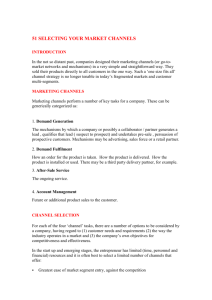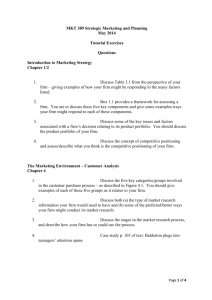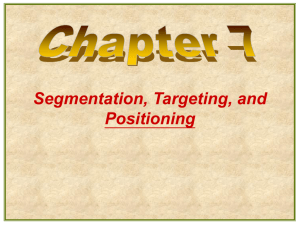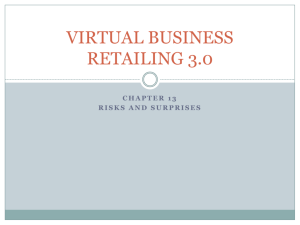Ch 10 - Marketing Ch..
advertisement
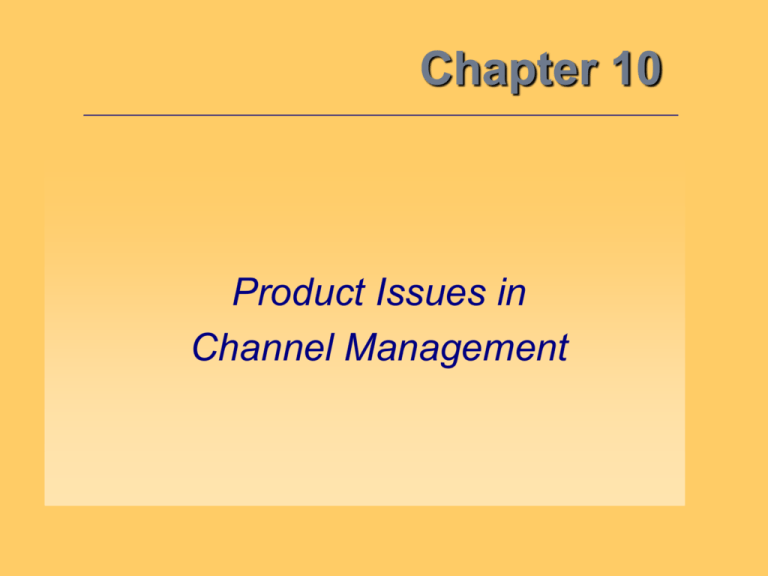
Chapter 10 Product Issues in Channel Management Objective 1: Marketing Mix Resources • Channel System Synergy – Critical for the channel manager to understand how all marketing mix variables are independent, yet interdependent in order to create the synergy necessary for meeting the customers’ needs & wants. 10 Objective 2: The Product/Channel Management Interface • 3 Major Areas of Product Management: 1. New product planning & development (NPD) 2. The product life cycle (PLC) 3. Strategic product management (SPM) 10 Objective 3: New Product Planning & Development • 5 Questions Channel Managers Must Ask: 1. What input, if any, can channel members provide in new product planning? 2. What has been done to ensure that the new products will be acceptable to channel members? 3. Do the new products fit into the present channel members’ assortments? 4. Will any special education/training be needed for members to sell the new products effectively? 5. Will the product cause the channel members any special problems? 10 Member Input • Channel members can provide valuable feedback during the product planning & development stage. • Members can… – Offer explicit new ideas for development – Explain the value in offering particular sizes, colors, or the use of packaging – Assist in gathering customer feedback during test-marketing or early commercialization 10 Member Acceptance of New Products • Likely key considerations for channel members’ acceptance of new product… 1. How will the product sell? 2. Is the product easy to stock and display? 3. Will the product be profitable to sell? 4. Does the product fit with one’s existing positioning efforts and/or merchandise mix? 10 Educating Channel Members • The channel manager’s goal is to sell the new product(s) as successfully as possible Thus, • One must educate & train members in the product’s use, special features to emphasize during sales, and how it fits in with the members’ existing merchandise mixes.* 10 Trouble-Free New Products • An increase in the care taken during the planning & development stages of the new product (including which members would likely desire the product and the necessary features for their handling of the product) will always decrease the number of potential problems associated with a new product offering. 10 Objective 4: 10 The Product Life Cycle Sales ($) Sales Profits Time Introduction Growth Maturity Decline The Introduction Phase • Channel Managers must… – Ensure there’s a sufficient number of channel members to gain market coverage – Ensure there’s an adequate supply of product on channel members’ shelves • Remember profits are negative in this phase due to negative economies of scale, so immediate sales growth is critical* 10 The Growth Phase • Channel managers must… – Ensure sufficient number of channel members’ inventories are adequate to cover sales growth – Monitor the entry and effects of competitive products on channel members • Remember that sales growth is extremely rapid here & increasing profits will drive competitors to enter the market, so member support is critical for profit longevity.* 10 The Maturity Phase • Channel managers must… – Provide extra emphasis on motivating channel members to curtail competitive attacks – Investigate the possibility for changes in the channel’s structure to extend maturity or possibly create a new PLC • Remember market-share peaks here & profits fall as competitive attacks ensue. Members are critical here to slow pace.* 10 The Decline Phase • Channel managers must… – Phase out marginal channel members and streamline their overall channel – Investigate the impact of product deletion on channel members’ needs & problems (Ch. 9) • Remember that although a product may begin to appear a “dog”, members may need to maintain the product to ensure their image & merchandise mix are complete.* 10 Objective 5: Strategic Product Management • Successful product strategies depend on… • The product’s – Quality (or value proposition*), innovativeness, or technological sophistication • The manager’s – Ability to oversee the product line & future needs • The firm’s – Financial capacity & willingness to provide promotional support • The other member’s – Willingness to implement the channel manager’s strategies (i.e., motivation ~ Ch. 9) 10 Objective 6: Product Strategies • Possible product strategies include… – Product differentiation – Product positioning – Product line expansion or contraction – Trading up or down – Branding strategies 10 Product Differentiation • Differentiation revolves around perception of its ability to solve a problem • Implications for channel management… – Select & support members who “fit” the image • Particularly when image is affected by who is selling – Provide support/training to retailers to sell “properly” • Particularly when either a “search” or “experience” good that requires personal selling 10 Product Positioning • Positioning focuses on perception in relation to competitive products • Implications for channel management… – “Match” between positioning efforts & possible seller must be considered before implementation – Must have retailer “buy-in” to maintain positioning & understand the attractiveness of certain incentives (Ch. 9) to different retailers. 10 Product Line Expansion or Contraction • Refers to the overall breadth (or assortment) of a product line • Implications for channel management… – Expansion & contraction can occur simultaneously (e.g., in a line’s depth*), but not in the same line – Difficult to balance member satisfaction & support as each wants their “right” merchandise mix 10 Trading Up or Down • Refers to the adding higher- (or lower-) priced lines of product to one’s mix • Implications for channel management… – Retailers must provide adequate coverage of either high- and/or low-end market segments for which the trade-up or trade-down is targeted – Retailers must provide appropriate salesmanship to trade-up or -down customers based upon manufacturer’s promotional support 10 Branding Strategies • Refers to the choice of selling both under a national, as well as a private, brand name • Implications for channel management… – Direct competition with channel members may result – Sell national & private brand versions in different geographical markets – Physically vary the products enough to minimize direct competition 10 Objective 7: Product Service Strategy • Remember that we no longer simply focus on the transaction because we’re not just selling products…we’re making value propositions. • Service is part of the “problem solution” sold. – Manufacturers must ensure that service is provided after the sale… • • • • By offering it directly (at factory or own service center) Offering it through its channel members (e.g., retailers) Endorsing authorized, independent service centers, or Some combination of the above 10





